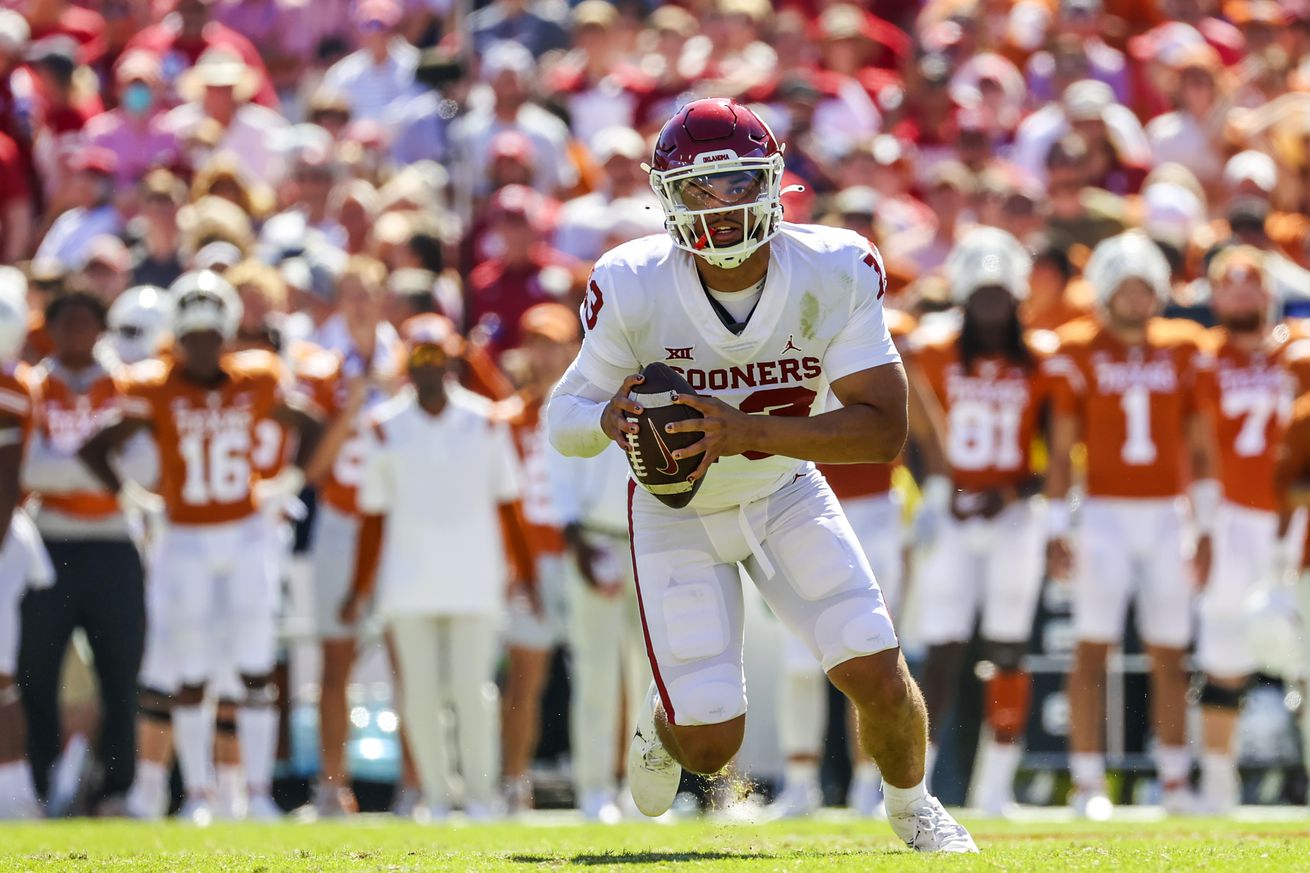
It’s Caleb Williams’ world for now, but OU can still win with Spencer Rattler at QB.
The old football saying goes something like, “When you have two quarterbacks, you don’t have a quarterback.”
What a dumb saying. You won’t find a more important position in sports. If they’re good, you want as many quarterbacks on your team as circumstances allow.
The Oklahoma Sooners currently have two. In guiding the squad to a thrilling 55-48 win over the Texas Longhorns in the Red River Showdown over the weekend, ballyhooed freshman Caleb Williams showed why he is seen as OU’s QB of the future. He’s almost certainly OU’s QB of the present after that performance.
Spencer Rattler’s detractors are legion, but he gave Lincoln Riley a reason to put so much faith in his ability when recruiting him out of high school. Whatever his faults, you simply cannot deny Rattler’s immense potential. And it’s not merely potential, either: The Sooners have a 15-2 record in games Rattler has started at quarterback, not to mention a Big 12 championship to their credit. They’ve been winning with him running the show.
If having those two quarterbacks on your team is a problem, it’s a good one to have. But what is the best way to maximize their talents in what remains of the season?
What happened in Dallas
We should start with what happened on Saturday: Rattler’s benching felt like a microcosm of what we’ve seen from the OU offense all season.
Using their standard 2-4-5 base alignment, the Longhorns bottled up OU’s running game with Rattler behind center in the first half. Excluding sacks and Williams’ 66-yard touchdown run, the Sooners rushed for 49 yards on 15 carries in the first two quarters when Rattler was taking snaps. The Horns showed little concern for Rattler’s ability to run, and the Sooners OL couldn’t block the UT front well enough to move the ball on the ground without shifting from OU’s preferred 11 personnel grouping to two tight ends as a standard alignment. Of course, going to 12 personnel created its own set of problems because it meant taking a dangerous passing threat off the field.
The Sooners could have lived with a diminished rushing attack if they could throw the ball well enough to keep the chains moving. Unfortunately, it became apparent after Rattler’s second turnover (and a few other near misses) that he wasn’t protecting the ball well enough to keep OU in the game.
/cdn.vox-cdn.com/uploads/chorus_asset/file/22925828/usa_today_16923539.jpg)
Kevin Jairaj-USA TODAY Sports
It doesn’t seem like a coincidence that OU’s ground game shifted into a higher gear after Riley inserted Williams at QB late in the second quarter. The Sooners rushed for 216 yards on 23 attempts from that point forward. Add in Williams’ TD jaunt earlier in the game and OU averaged 11.8 yards per carry with Williams at QB.
With Texas forced to respect Williams as a runner, running backs Kennedy Brooks and Eric Gray combined for 188 yards on 17 rushes. Meanwhile, Williams’ mobility enabled him to elude the Texas pass rush and wear out the defenders giving him chase.
What happens next?
/cdn.vox-cdn.com/uploads/chorus_asset/file/22925829/usa_today_16923640.jpg)
Kevin Jairaj-USA TODAY Sports
To be clear: It didn’t take surreptitiously observing an OU practice this week to know Caleb Williams would be the first-string QB when the Sooners hit the field Saturday night against TCU. Riley said as much without actually saying it at his media availability on Tuesday when he mentioned that Rattler got a day off from practice on Monday. Moreover, we all saw what happened in the last game.
Keep in mind, though, that everyone outside the program doesn’t know what we don’t know. Riley made Rattler the starter at QB for a reason, and OU’s head coach never displayed any signs of doubt about the decision. He gave Williams the occasional snap in short-yardage situations, but there were no other packages for the freshman signal caller incorporated into the offense. Riley handed Williams the reins only after Rattler appeared close to imploding.
That should make all of us on the other side of Norman’s iron curtain wonder why Riley didn’t take a more proactive approach to getting Williams in games earlier. And what happens when opponents spend the week before a game preparing for Williams at QB? Taking over against a team like Texas that built its defensive game plan around the other QB is one thing, but a team gunning specifically for you is something else entirely.
Given the up-and-down performance of OU’s offensive line so far, Williams’ mobility ultimately raises the ceiling of this offense. Importantly, the Sooners are at their best when they can leverage an arsenal of talented receivers – Williams works well in personnel groupings with more of them on the field.
Considering Rattler’s prodigious talents as a passer, though, you understand why Riley is so keen to keep him in the fold. It seems like a tall order to play some kind of rotating system of QBs at this point in the season, but it’s not impossible. Riley could even lean into Rattler’s strengths by playing him in 12 personnel groupings, forcing defenses to adjust midstream to more power running and play-action passing.
OU will probably ride with Williams for the foreseeable future. But so long as Rattler stays engaged, the Sooners could still win plenty of games with him at wheel.